Red Hand of Ulster
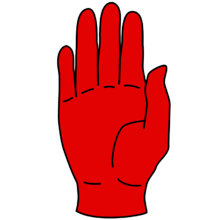
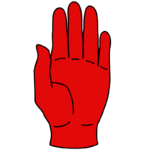
The Red Hand of Ulster (Irish: Lámh Dhearg Uladh) is an Irish symbol used in heraldry[1] to denote the Irish province of Ulster. It is an open hand coloured red, with the fingers pointing upwards, the thumb held parallel to the fingers, and the palm facing forward. It is usually shown as a right hand, but is sometimes a left hand, such as in the coats of arms of baronets.
Historical background
The Red Hand is first documented in the 13th-century where it was used by the Hiberno-Norman de Burgh earls of Ulster.[2] It was Walter de Burgh who became first Earl of Ulster in 1243 who combined the de Burgh cross with the Red Hand to create a flag that represented the Earldom of Ulster and later became the modern Flag of Ulster.
It was afterwards adopted by the O'Neills upon their assumption of the supremacy of the ancient Ulaid kingship, inventing the title Rex Ultonie (king of Ulster) for themselves in 1317 and then claiming it unopposed from 1345 onwards.[3][4][5] An early Irish heraldic use in Ireland of the open right hand can be seen in the seal of Aodh Ó Néill, king of the Irish of Ulster, 1344-1364.[6]
Despite this it is claimed that the symbol was still seen as rightfully that of the Magenniss of Iveagh, the predominant surviving dynasty of the Cruithin, even in the late 17th-century.[2]
The exclusive right to the use of the Red Hand symbol was still a matter of dispute in the 16th century, with a poem indicating disagreement between the "Síol Rúraí" (the Clanna Rudraige of Ulaid, now represented by the Magennis' of Iveagh) and the northern descendants of Niall Noígíallach (the O'Neills).
The Red Hand symbol is believed to have been used by the Uí Néill clan during its Nine Years' War (1594–1603) against the spread of English control. The war cry Lámh Dhearg Abú! (Red Hand to victory!) was also associated with the Uí Néill.[7] During the reign of Elizabeth I an English writer of the time noted "The Ancient Red Hand of Ulster, the bloody Red Hand, a terrible cognizance! And in allusion to that terrible cognizance- the battle cry of Lamh dearg abu!"[5]
During the plantation of Ulster it was part of the arms of The Irish Society;[8] sales of baronetcies originally helped fund the plantation so baronets of England and of Ireland and later baronets of Great Britain and of the United Kingdom were allowed to augment their arms with a "hand gules".[9]
Traditional background
The Red Hand is rooted in Gaelic culture however its real origin and meaning is unknown, but it is believed to date back to pagan times.
According to one tradition it is attributed to the mythical Irish figure Labraid Lámh Dhearg (Red Hand Labraid), of the Fenian Cycle of Irish mythology.[1][10] According to Eugene O'Curry, Labraid Lámh Dhearg is cited by in one Irish legend as being king of the Dál nAraidi branch of the Cruithin of Ulaid during the reign of the mythical Conchobar Mac Nessa.[11][12] Another states that Labraid was the son of the Celtic god Nuada silver-hand.[13]
Alternatively the Red Hand may have came to symbolise the "Hand of God" in Christianity. An example of this motif can be seen on the 10th century Muiredach's High Cross at Monasterboice, County Louth. Another suggestion is that the Red Hand was associated with sovereignty and represented the derbfine. Gaelic chieftains and kings were elected from among a group of men (the derbfine) who shared the same great-grandfather. The palm may represent the great-grandfather with the three jointed divisions of the fingers representing his sons, grandsons, and great-grandsons.[14]
According to another legend, the kingdom of Ulster had at one time no rightful heir. Because of this, it is agreed that a boat race should take place and that "whosoever's hand is the first to touch the shore of Ireland, so shall he be made the king". One potential king so desires the kingship that, upon seeing that he is losing the race, he cuts off his hand and throws it to the shore—thus winning the kingship. The hand is red to represent the fact that it would have been covered in blood. In some versions of the tale, the king who cuts off his hand belongs to the Uí Néill clan, or is Niall of the Nine Hostages himself. In other versions, the king is the mythical Érimón.[15]
Another legend tells of two giants fighting each other. One has his hand cut off by the other, and a red imprint of the hand is left on the rocks.[16]
Modern usage
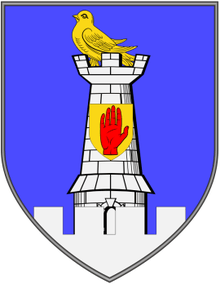
The form in common use is an open right (dexter) hand coloured red, with the fingers pointing upwards, the thumb held parallel to the fingers, and the palm facing forward.
Coats of arms used by those whose surnames are of Uí Néill descent – Ó Donnghaile, Ó Catháin, Mac Aodha, Ó Dálaigh, Ó Maéilsheachlainn and Ó Ceatharnaigh, to name just a few – all feature the Red Hand in some form. On the Ó Néill coat of arms featuring the Red Hand, the motto is Lámh Dhearg Éireann (Red Hand of Ireland).[17] The arms of the chiefs of the Scottish Clan MacNeil (of Barra) contain the Red Hand; the clan has traditionally claimed descent from Niall of the Nine Hostages. Many other families have used the Red Hand to highlight an Ulster ancestry. The head of the Guinness family, the Earl of Iveagh, has three Red Hands on his arms granted as recently as 1891.[18]
The Red Hand is present on a number of Ulster counties crests such as Antrim, Cavan, Londonderry, Monaghan and Tyrone. It was later included in the now abolished Government of Northern Ireland flag. It is also used by many other official and non-official organisations throughout the province of Ulster and the rest of Ireland.
The Red Hand can be regarded as one of the very few cross-community symbols used in Northern Ireland (which makes up 6 of Ulster's 9 Counties) crossing the sectarian political divide. Due to its roots as a Gaelic Irish symbol, nationalist/republican groups have used (and continue to use) it – for example the republican Irish Citizen Army, the republican National Graves Association, Belfast, the Irish Transport and General Workers Union, the Ulster GAA association GAA clubs in Ulster . Other organisations within the nine counties of Ulster and also supported within the political sectarian divide, use it happily in the six Ulster counties within Northern Ireland, such as the Ulster Hockey Union, these are supported from both sides of the community- nationalist and unionist. As the most identifiable symbol of Ulster, at the start of the 20th century it has also been used by Northern Ireland's unionists and loyalists, such as its use in the Ulster Covenant (1912) and in the arms of the Government of Northern Ireland (from 1922 and now abolished), the Ulster Banner (the former flag of the Northern Ireland government), the Ulster Volunteers and loyalist paramilitary groups based only within Northern Ireland such as the Ulster Volunteer Force and Ulster Defence Association among others.
Baronets
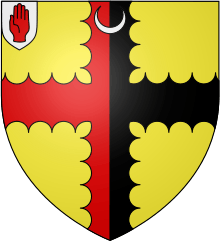
A left (sinister) Red Hand is an option for baronets to add to their arms to indicate their rank. The College of Arms formally allowed this in 1835, ruling that the baronets of England, Ireland, Great Britain or the United Kingdom may "bear either a canton in their coat of arms, or in an escutcheon, at their pleasure, the arms of Ulster (to wit) a Hand Gules or a Bloody Hand in a Field Argent."[20] It is blazoned as follows: A hand sinister couped at the wrist extended in pale gules.[21]
King James I of England established the hereditary Order of Baronets in England on 22 May 1611, in the words of Collins (1741): "for the plantation and protection of the whole Kingdom of Ireland, but more especially for the defence and security of the Province of Ulster, and therefore for their distinction those of this order and their descendants may bear (the Red Hand of Ulster) in their coats of arms either in a canton or an escutcheon at their election".[22] Such baronets may also display the Red Hand of Ulster on its own as a badge, suspended by a ribbon below the shield of arms.[23] Baronets of Nova Scotia, unlike other baronets, do not use the Red Hand of Ulster, but have their own badge showing the Saltire of St Andrew.[20] The left-hand version has also been used by the Irish National Foresters, the Irish Citizen Army and the Federated Workers' Union of Ireland.
Examples
 Original Red Hand Seal of Ó Néill
Original Red Hand Seal of Ó Néill The flag of the province of Ulster
The flag of the province of Ulster Four Provinces Flag of Ireland
Four Provinces Flag of Ireland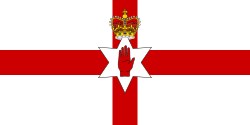 The former flag of the Northern Ireland government (1953–1972)
The former flag of the Northern Ireland government (1953–1972) Badge worn by baronets of the United Kingdom
Badge worn by baronets of the United Kingdom- Seal with left hand for the Curtius baronets
 The coat of arms of the GNR.
The coat of arms of the GNR. Republican National Graves Association Belfast
Republican National Graves Association Belfast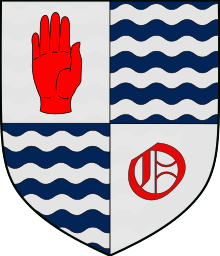 Arms of O'Neill Hall at the University of Notre Dame
Arms of O'Neill Hall at the University of Notre Dame
References
- 1 2 "Irish Ancestors /Heraldic traditions". The Irish Times.
- 1 2 Schlegel, Donald M. (2002). Reweaving the Tapestry of Ancient Ulster. Clogher Record. Clogher Historical Society. p. 747-9.
- ↑ Duffy, Seán (2005). Medieval Ireland An Encyclopedia. Routledge. p. 231. ISBN 0-415-94052-4.
- ↑ Duffy, Seán (2005). Medieval Ireland An Encyclopedia. Routledge. p. 481. ISBN 0-415-94052-4.
- 1 2 John Cornelius O'Callaghan. "History of the Irish Brigades in the service of France". Cameron and Ferguson.
- ↑ National Library of Ireland Heraldry In Ireland
- ↑ Traynor. "VI.-- THE ANCIENT KINGDOM OF CONNAUGHT". Angelfire.com.
- ↑ "Wars and Conflicts - Plantation of Ulster - English and Scottish Planters - The London Companies". BBC.
- ↑ "Ulster Divisional Badge". 36thulsterdivision.com.
- ↑ "Search Results for Labraid Lámderg". Oxford Reference.
- ↑ On the Manners and Customs of the Ancient Irish, III. Kessinger Publishing. 2010. ISBN 978-1163577769.
- ↑ Schlegel, Donald M. (2002). Reweaving the Tapestry of Ancient Ulster. Clogher Record. Clogher Historical Society. p. 728.
- ↑ Grenham, John. Irish Family Names. Roberts Wholesale Books, 2000. p.31
- ↑ Burke, Bernard. Burke's introduction to Irish ancestry. Burke's Peerage Ltd., 1976. p.40
- ↑ The Red Hand of Ulster
- ↑ Anderson, Darran. "Red Hands Up if you Know the Answer". Culture Northern Ireland.
- ↑ "O Neill, Neill, Neale, Neil". Araltas.com.
- ↑ Burke's Peerage, London 2003, sub "Iveagh"
- ↑ Mosley, Charles, ed. (2003). Burke's Peerage, Baronetage & Knighthood (107 ed.). Burke's Peerage & Gentry. p. 524. ISBN 0-9711966-2-1.
- 1 2 Pixley, F.S.A, Francis W. (2016) [1900]. A History of The Baronetage. pp. 262–269. ISBN 9780956815750. Retrieved 6 July 2017.
- ↑ Collins, Arthur, The English Baronetage: Containing a Genealogical and Historical Account of all the English Baronets now Existing, Volume 4, London, 1741, p.287
- ↑ Collins, 1741, vol.4, p.287
- ↑ Debrett's Peerage, 1968, p.1235